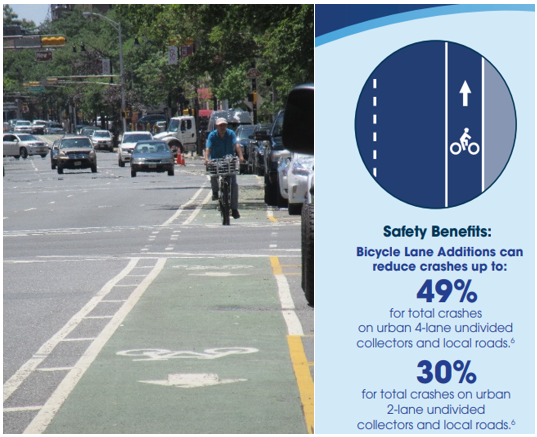This final article in the Federal Highway Administration (FHWA) Proven Safety Countermeasures series explores additional proven options that can be used to accelerate the achievement of local, State, and National safety goals.
Bicycle lanes are an important countermeasure for improving bicyclist safety. As of August, statewide bicyclist fatalities already surpassed the total tally of 9 in 2021, with 14 recorded so far in 2022 (NJ State Police). Bicyclists are at high risk for serious injury because they often share lanes with motor vehicles. Almost one-third of bicycle-vehicle crashes occur at locations other than intersections when motorists overtake bicyclists (Thomas et al., 2019). The FHWA advocates the designation of dedicated bicycle lanes to increase the comfort and safety of riders. Bicycle lanes have been shown to reduce total crashes on urban 4-lane roads by up to 49 percent and by up to 30 percent on urban 2-lane roads.
Roundabouts effectively reduce the approach speed of vehicles and allow for safer and more effective movement through intersections, resulting in fewer conflicts. The need for motorists to approach a roundabout at a lower speed increases the likelihood of yielding to vulnerable users and reduces the probability of severe injuries if a crash occurs. When switching from a two-way stop-controlled intersection, roundabouts have been shown to reduce fatal and serious injury crashes by 82 percent. When switching from a signalized intersection, roundabouts have been shown to reduce fatalities and serious injuries by 78 percent.
Proven safety countermeasures focused on roadway and intersection design prioritize safety, comfort, and accessibility over speed, often reallocating roadway space for all users. One example of these types of countermeasures discussed in our first article is a road diet (or lane reduction), which results in fewer lanes for pedestrians to cross and allows more space for the installation of pedestrian refuge islands, bicycle lanes, on-street parking, or other interventions. Other countermeasures that reallocate space include lane narrowing, curb radius reduction, modified skewed intersections, and chicanes[1]. By reallocating space on the roadway, these countermeasures aim to reduce the crossing distance and conflict points while reducing vehicle to increase safety for vulnerable road users.
As one of its crosscutting countermeasures, the FHWA recommends that transportation agencies conduct a road safety audits (RSA). An RSA is performed by a multi-disciplinary team independent of the project to consider all road users, account for human factors and road user capabilities. The audits are documented in a formal report and require a formal response from the road owner, preferably at the early stages of the project, to explore the potential risks for vulnerable users and provide strategic solutions. Depending on the stage of the project when it is conducted, the road safety audit has been shown to reduce the number of total crashes by between 10 and 60 percent.
[1] http://www.pedbikesafe.org/pedsafe/countermeasures.cfm

